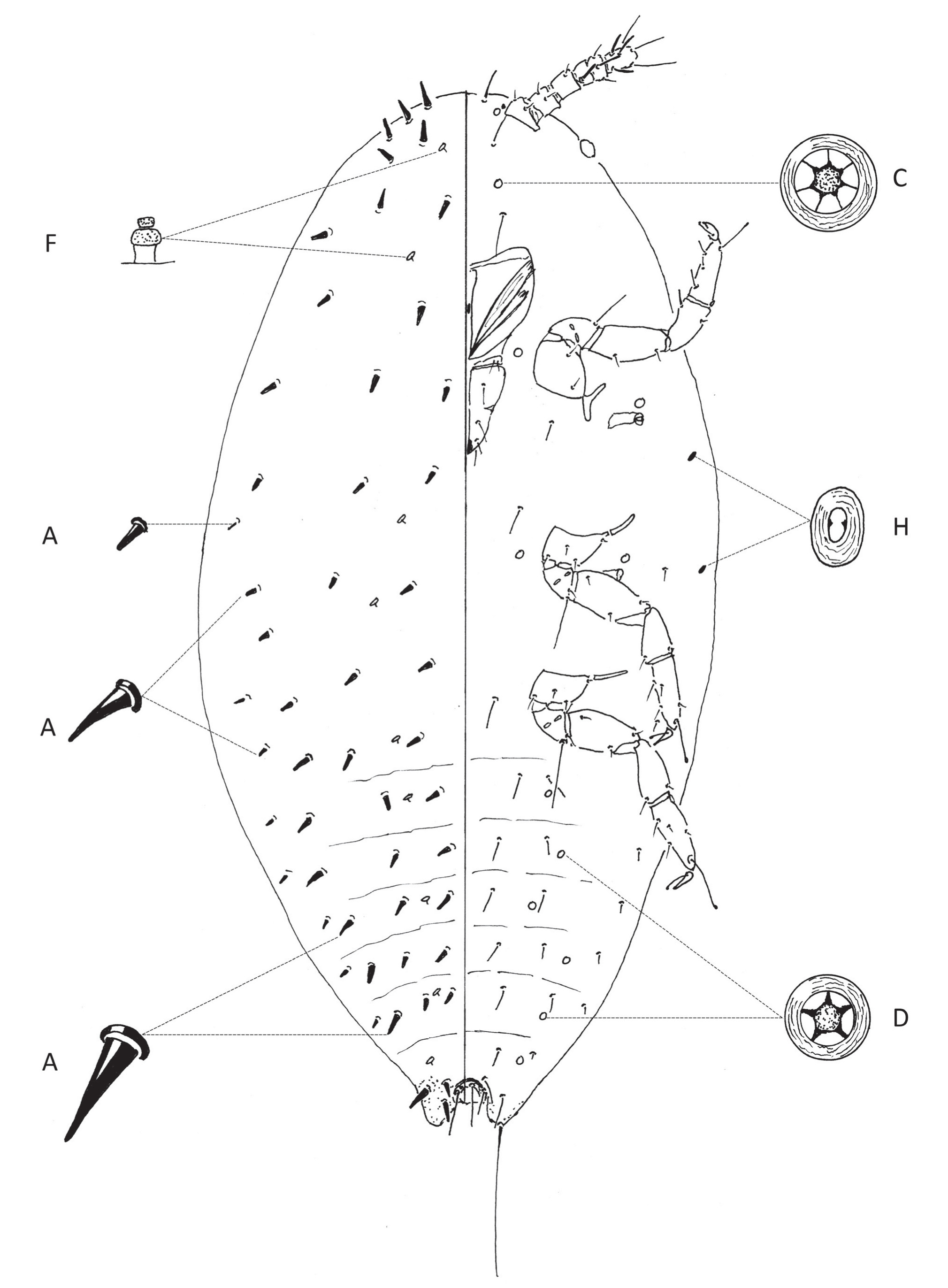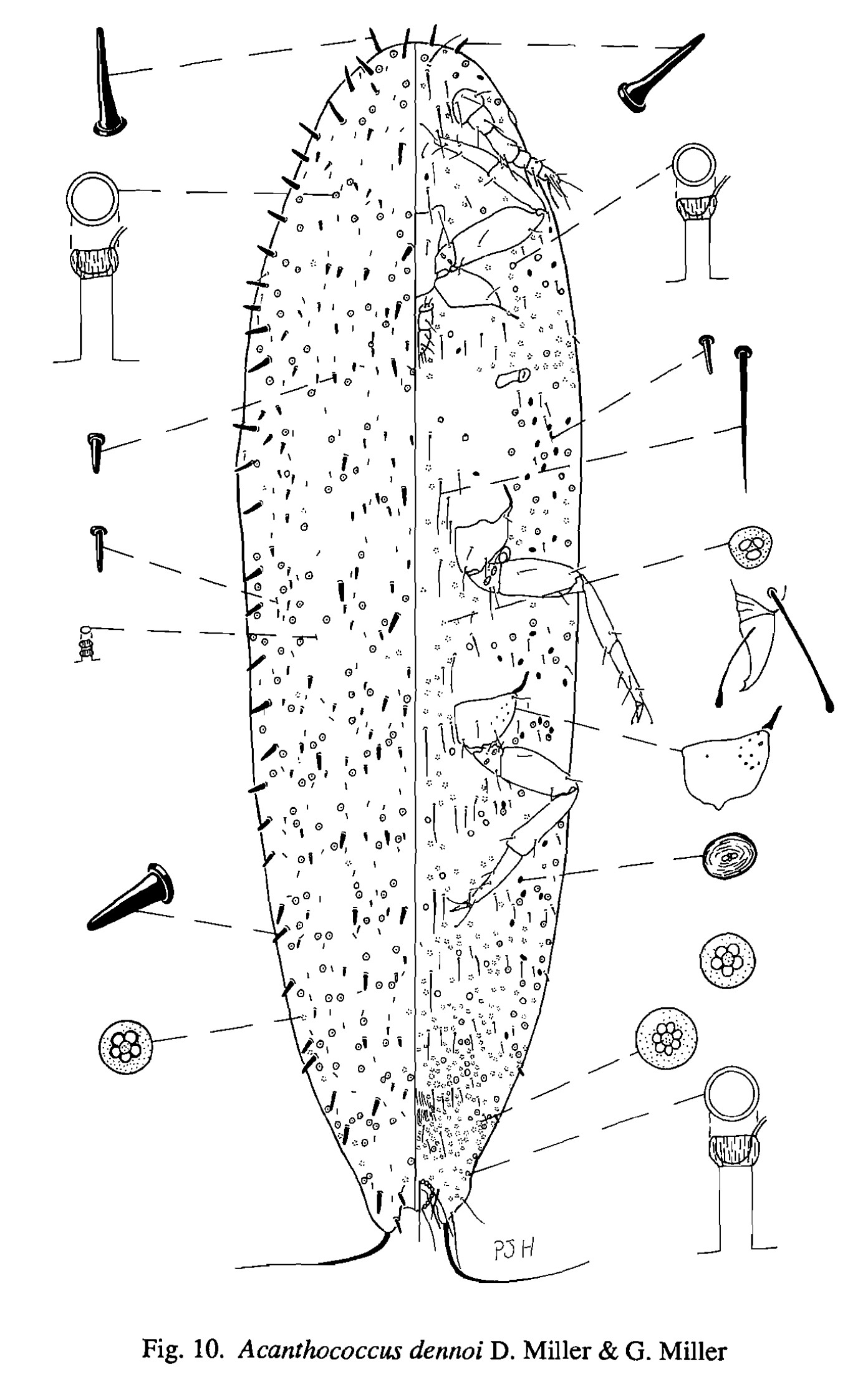Valid Names Results
Acanthococcus dennoi Miller & Miller, 1993 (Eriococcidae: Acanthococcus)Nomenclatural History
- Eriococcus n. sp. Denno 1977: 362. unavailable name that is placed
- Acanthococcus dennoi Miller & Miller 1993: 27-31. Type data: UNITED STATES: New Jersey, Ocean Co., two miles E. of Manahawkin off Stafford Ave., on Spartina patens, 17/07/1974, by R.F. Denno. Holotype, female, by original designation Type depository: Washington: United States National Entomological Collection, U.S. National Museum of Natural History, District of Columbia, USA; accepted valid name Illustr.
- Eriococcus dennoi (Miller & Miller, 1993); Miller & Gimpel 1999: 213. change of combination
- Acanthococcus dennoi Miller & Miller, 1993; Miller & Stocks 2022: 5. revived combination (previously published)
Common Names
- Denno eriococcin MillerMi1993
Ecological Associates
Hosts:
Families: 1 | Genera: 2
- Poaceae
- Distichlis spicata | MillerMi1993
- Spartina | MillerMi1993
- Spartina alterniflora | MillerMi1993
- Spartina patens | MillerMi1993
Geographic Distribution
Countries: 1
- United States
- Alabama | MillerMi1993
- Florida | MillerMi1993
- Georgia | MillerMi1993
- New Jersey | MillerMi1993
- South Carolina | MillerMi1993
- Virginia | MillerMi1993
Keys
- DeeterMiPo2025: pp.230 ( Adult (F) ) [Acanthococcus of Florida]
- MillerSt2022: pp.12 ( First instar ) [Acanthococcus species]
- Koszta1996: pp.228 ( Adult (F) ) [Acanthococcus species of Northeastern North America] Key as: Acanthococcus dennoi
- MillerMi1993: pp.8 ( Adult (F) ) [Acanthococcus species of the eastern United States] Key as: Acanthococcus dennoi
Remarks
- Systematics: Of the seven Acanthococcus species treated in Miller & Stocks (2022), the first-instar nymph of Ac. dennoi is most similar to the first-instar nymph of Ac. pennyae in having four setae on each hind tibia, five setae on each hind femur, and dorsomedial enlarged setae usually about same size as lateral setae. They differ as follows (character states in brackets are of Ac. dennoi): the predominant multilocular pore on the ventral abdomen with 3 loculi (5 loculi); cruciform pores absent (present). (Miller & Stocks, 2022)
- Structure: Slide-mounted adult female with: enlarged setae on posterior abdominal segments with blunt or rounded apices, setae on anterior thorax with acute apices, 2 setae on margin of each abdominal segment; medial enlarged setae on anal lobes cylindrical, of different shape than outer anal lobe setae; 4 setae on each tibia (Miller & Miller, 1993).
- Biology: Ovisacs produced on Spartina leaf blades. This species appears to have a single generation each year (Miller & Miller, 1993). Denno (1977) cites "small numbers of both adult males and females appeared during May, followed in early June by a large flux or crawlers that developed into 2nd instars by July. After July, the population of nymphs in samples decreased rapidly, due probably to a combination of dispersal, mortality and settling deep into the grass where they overwintered. Apparently, larger nymphs become active again in April when they move to the new grass shoots to complete development. At this time they are again retrieved in samples as evidenced by a spring peak of nymphs prior to the appearance of adults."
- General Remarks: Detailed description and illustration by Miller & Miller (1993). Illustration of first instar nymph in Miller & Stocks (2022)
Illustrations
Citations
- DeeterMiPo2025: key, 230
- Denno1977: distribution, host, 362, 365
- Koszta1996: description, distribution, host, illustration, life history, taxonomy, 228, 236, 237
- Kozar2009: distribution, taxonomy, 98
- Miller2005: distribution, 491
- MillerGi1999: taxonomy, 213
- MillerGi2000: catalog, description, distribution, host, life history, taxonomy, 188
- MillerMi1993: description, distribution, host, illustration, taxonomy, 8, 27-31
- MillerSt2022: diagnosis, illustration, key, nymph, 12, 17-18
- PooleGe1997: distribution, 354
- RauppDe1979: biology, distribution, 413, 414




